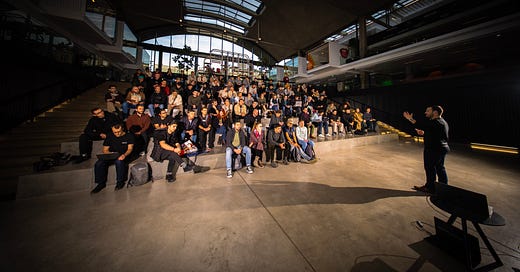The third European Defense Tech Hackathon happened this weekend in Paris, and it was pretty awesome. The vibe has definitely shifted, at least within the private community, and funnily enough in every country that has a border to Russia. We welcomed officials from French agencies and ministry of defense, among others Noémie Gélis, Chief of the Office of Strategic Anticipation of the procurement agency for the MoD (brilliant title btw). There are ways for entrepreneurs to interact with the DGA, but it’s not that easy. Something they recognize. Defense Tech startups in France took a moral hit this year with the acquisition and effective block of the sale of Preligens to Palantir. Instead they were sold for $220M on the dollar to Safran, a French prime.
A full write-up is in the making and will cover some of the projects built during this weekend and the last one in Copenhagen. In the meantime, sign up for the next one in Munich coinciding with the Munich Security Conference.
🤼 People
Kristjan Pihus - CTO at DefSecIntel
When Kristjan joined DefSecIntel as a CTO, they were 4 people in 2022. Now they’re 80. If you don’t know DefSecIntel, it’s maybe because you’re a VC and DefSecIntel has been a cashflow financed/bootstrapped company doing quite well selling border surveillance products in the Baltics and other regions preparing for invasion. Kristjan presented some of the learnings he’s made in developing products for harsh conditions, e.g., GNSS-denied, low-comms environments.
With him as a mentor he had Madis Koplimäe - former special forces in the Estonian army, now heading up special projects for DefSecIntel.
💼 Portfolio jobs board
This weeks selection of opportunities from the portfolio:
🚀 Companies (more hackathon projects coming next week!)
Beholder - AI for minerals exploration
Status: Grant
Source: EDTH
Founders: Serhii Lubkin, Daniil Lubkin
Why it’s cool:
Most mining companies don’t do exploration anymore, mostly exploitation. Less than 1% of exploration projects progress to a commercial mine, and it usually takes 20-30 years. Beholder thinks they can improve on that significantly, which could move the success rate to 75%.
Farsight Vision - turning geospatial data into 3D models
Status: Pre-seed
Source: EDTH
Founders: Viktoriia Yaremchuk, Volodymyr Nepiuk
Why it’s cool:
We’re accumulating geospatial footage data faster than ever before, with Ukraine producing over 1.3 million drones this year and more earth-observation satellites being in orbit than ever. To make sense of that data, we need intelligence to turn 2D into 3D, points into graphical objects, and objects into semantic objects.
Glid - Autonomous road to rail
Status: Founded in 2022
Source: Discord
Founders: Kevin Damoa, Craig Woolridge, Matt Mueller
Why it’s cool:
Moving big physical things takes people, time and energy. Which is costly ICYMI. Shipping improved by orders of magnitude in terms of efficiency in the 1960’s because of the widespread adoption of the container standard. Glid (which means glide in Swedish perhaps accidentally), wants to help move containers from trucks to rail and back autonomously. They’ll do it on private property, meaning it can be done without having to respect traffic regulations.
💡 Ideas & Science
US agency approves T-Mobile, SpaceX license to extend coverage to dead zones
SpaceX/Starlink is now allowed to deliver direct-to-cell services in the US, as of a recent license approval from the Federal Communications Commission. However, they did not get a response on their request to defer the out-of-band-emissions requirement set by the FCC, so they’ll need to lower the transmission power to something that will cap them at text services most likely. For now.
NASA aircraft uncovers site of secret Cold War nuclear missile tunnels under Greenland ice sheet
Turns out the US was interested in Greenland long before Trump and Dryden Brown looked hungrily their way! Cool to see this was “rediscovered” after decades.
The case for AI for Science at Deepmind
Great read recommended by Matt Clifford of EF. From drug or materials discovery to literature reviews and coding. AI can help in many many branches of science. When it comes to helping scientist understand which parts of rapidly growing fields they need to extract what information from to solve their question, AI is the perfect helper. Deepmind lays out 5 areas of opportunity: Knowledge, data, experiments, models and solutions. Then lays out what “ingredients” are needed for successful implementation of these AIs, from problem selection to adoption. They also talk about policy and risks.





